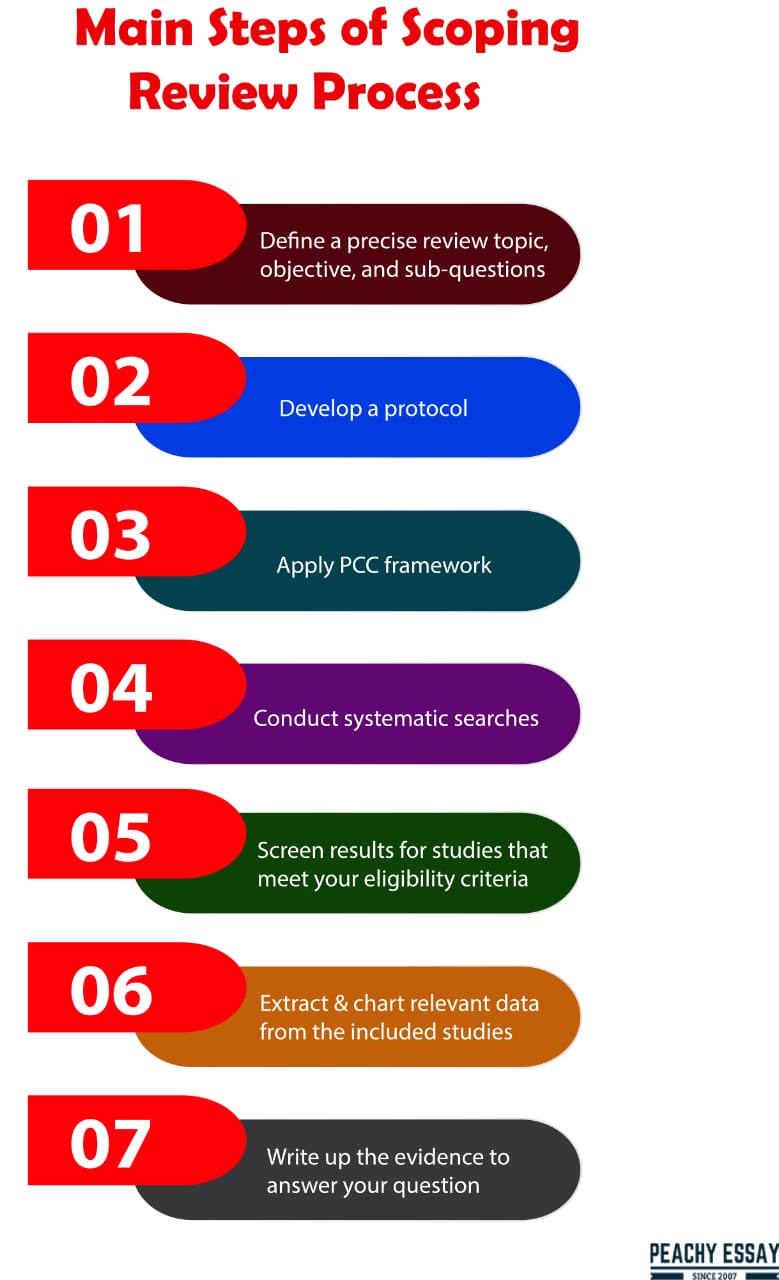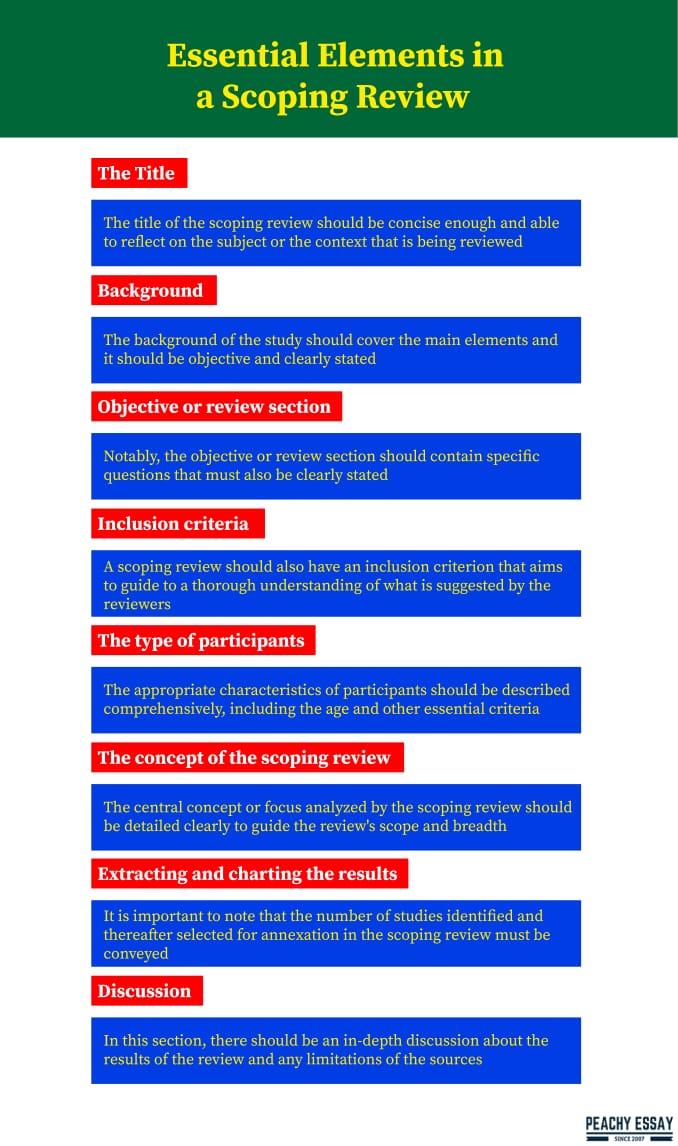It is essential to note that systematic reviews started in the 1970s and 1980s and were primarily used in healthcare. With time, they have significantly advanced in popularity. Currently, systematic reviews are often undertaken with a wide range of objectives within different fields. Recently, the evidence in the synthesis has led to the appearance of the scoping reviews that are almost similar to the systematic reviews, only that they have a specified structured process. Scoping reviews are always performed for specific reasons, and they have significant methodological differences.
First and foremost, scoping reviews have a general drawback because they cannot meet the requirements or objectives of the user’s degree of knowledge. There are clear guidelines regarding scoping reviews, how to conduct them, and the different steps involved in the entire process. However, it is essential to note that most of these guidelines are not straightforward. As the peer reviewer and editor for different journals, I have noted confusion and inconsistency in the indications used in scoping reviews. On the same note, there is a lack of clarity regarding when a particular scoping review should be conducted instead of a systematic review.
By the most straightforward definition, systematic reviews are defined as research synthesis performed by review groups with specialized skills. These groups are set out to retrieve and identify international evidence relevant to a particular question. On the same note, they also synthesize and appraise the research results to inform policies, practice, and further research. It is essential to note that systematic reviews are always aimed at minimizing biases and providing a more reliable finding out from which decisions can be made and conclusions are drawn. Students and other researchers should also never forget that systematic reviews adhere to a specific structure and a predefined process, requiring an individual to use rigorous methods that will ensure that the obtained results are meaningful and reliable to the end-user.
Indications of Scoping Reviews
Just like their name suggest, scoping reviews play an essential role in determining the coverage or the scope of a certain body of literature on a particular topic. Scoping reviews aim to offer a clear indication of the volume of literature and studies available for various overviews. The scoping reviews play an essential role in examining the evidence, especially when it is unclear what kind of questions can be used to address specific systematic reviews. During such situations, the scoping reviews aid in informing different practices in the field and the way particular research has been done.
It is important to note that one of the primary objectives of conducting a scoping review is to map and thereafter identify the available pieces of evidence. Different researchers acknowledge that there is no specific recognized definition for scoping reviews. On the same note, there is no particular reason for conducting them. However, other researchers believe that the following are some of the reasons for conducting a scoping review: identifying the type of evidence in a particular field, clarifying the primary concepts as well as definitions in the literature, examining the mode in which specific research was done, especially on a particular field or topic, and identifying some of the critical characteristics of the factors related to a particular concept. Other reasons for conducting a scoping review are that it acts as one of the precursors to s systematic review and that it aids in identifying and analyzing various knowledge gaps.
Key Differences Between a Systematic and Scoping Review
It is essential to note that the scoping reviews are often seen as a valid approach towards specific indications. One of the most significant differences between systematic and scoping reviews is in terms of the questions being reviewed. A scoping review will contain a broader scope as compared with the traditional systematic review. On the same note, a systematic review will differ from a scoping review based on their overriding principle. Researchers need to discuss the primary objectives and questions of scoping reviews. This is because a failure to do so may lead to different forms of difficulties in the review process. The other key difference between a scoping and a systematic review is based on the various purposes and primary objectives. For instance, the primary objective of a scoping review is mapping the body of literature regarding a particular topic. On the other hand, the primary objective of a systematic review is, to sum up, the most influential research on a specific topic.
A scoping review aims to present an overview of a potentially diverse and large body of literature regarding a specific topic. On the other hand, a systematic review seeks to collate empirical evidence from a smaller number of studies, and they focus on researching a particular question. Secondly, it is important to note that scoping reviews include a more significant range of methodologies and study designs than other systematic reviews that often address the effectiveness of a particular intervention and concentrate on randomized controlled trials.
On the third note, researchers should never forget that the scoping reviews aim to provide a descriptive overview of a particular reviewed material without critically synthesizing evidence from different studies or appraising individual research. On the contrary, systematic reviews aim to provide a synthesis of evidence obtained from studies assessed for having a risk of bias.
With a good understanding of the differences between scoping and a systematic review, individuals should still be cautious not to confuse it with traditional literature reviews. Since the ancient days, literature reviews have been used to summarize different research and publications on various topics. In traditional literature studies, the researcher aims to research topics and theoretical or conceptual literature that mainly concentrates on the history, the importance, and the collective thinking on a specific topic, concept, or issue. Both systematic and scoping reviews are considered subjective because of their substantial dependence on pre-existing experience and knowledge. However, when it comes to scoping reviews, they are generally unbiased, exhaustive, and systematic.
Despite the limitations of traditional literature reviews, they still perform an essential role in providing an overview of an issue or a topic. It is important to note that scoping reviews aids in providing a necessary alternative to the literature review, and they are primarily used in making clarifications based on a particular theory or concept. Principally, in recent years, it is essential to note that scoping reviews have increasingly been adopted and have been published in a wide range of disciplines and fields of study.
Reasons Why a Scoping Review may be Conducted
Traditionally, it is true that systematic reviews have combined different quantitative literature from different sources to respond to question on effectiveness. Scoping reviews are mostly preferred because of their feasibility, meaningfulness, and appropriateness, especially in the delivery of healthcare practices. The research questions in systematic reviews are mostly answered based on economic and qualitative evidence. Researchers are advised to begin their scoping reviews to develop a protocol followed by an extensive, replicable, and rigorous search for international literature. While the primary objective of a systematic review is to respond to a specific series of questions, a scoping review will have a broader approach that will aim to map the literature and address a more comprehensive research question.
Unlike a systematic review, the aim of a scoping review is one of the effective ways to map the main concepts, which underpin a particular research area. The scoping reviews can perform an essential role in combining different literature that has emerging evidence. Most importantly, the scoping reviews are conducted to map a particular literature body with a relevant origin, source, location, and time. Scoping reviews are undertaken to determine the extent of available research and the amount of information available on a particular topic, and how the research has been conducted. It is essential to highlight the unique distinction between a comprehensive systematic review and a scoping review. The good thing about the scoping review is that they draw upon information from different study designs in order to respond to a series of specific and related questions.
In a scoping review, the primary objective is synthesizing information from different study designs and knowledge obtained from qualitative evidence to enhance quantitative evidence. It is important to note that in a scoping review, the objective is to determine the different range of evidence available on a particular topic. The act of synthesis in scoping reviews is usually graphically represented. Finally, the other distinction between systematic and scoping reviews is that different from a systematic review, scoping reviews aim at offering an overview of the prevailing evidence base irrespective of quality. Therefore, a formal assessment of the methodological quality of the included studies is generally not performed.
Steps Involved in the Scoping Review Process
Seven main steps could be used in the scoping review process.

- Define a precise review topic, objective, and sub-questions
The primary aim of a scoping review is to answer clearly defined sub-questions and purposes drawn from a widespread issue. Before beginning your research, it is essential to have clear, focused, and well-informed questions. Having a well-defined review of sub-questions, objective, and topic enables an individual to search for evidence and make it easier to apply key concepts in research.
- Develop a protocol
A protocol is a methodology or a plan for a scoping review. A researcher needs to create a protocol before starting their research process. Apparently, you may decide to refine your protocols are your continue progressing through the entire review.
- Apply PCC framework
The PCC (Population (or participants)/Concept/Context) framework is usually commended for identifying the primary concepts that could be used in the process of reviewing different forms of research questions. Therefore it is essential to note that the framework enlightens an individual about the different search strategies. Researchers should never forget that when they break down their questions this way, they will see any missed exclusion or inclusion criteria in the protocol.
- Conduct systematic searches (including grey literature)
Conducting systematic searches entails having a good understanding of the exclusion and inclusion criteria that are used for studying inclusion and knowing where to look and search effectively for information. Unfortunately, the entire process is usually complicated, and hence, it is professionals that are employed to perform the systematic searches.
- Screen results for studies that meet your eligibility criteria
In this step, the researcher goes through different literature and assesses whether they meet the required standards for writing a scoping review. Individuals should be keen when performing this step since it is time-intensive and requires a lot of effort.
- Extract & chart relevant data from the included studies
All the relevant information is obtained from the sources that meet the eligibility criteria.
- Write up the evidence to answer your question
This is the final step in writing scoping reviews, and it is where an individual creates a write-up of all the evidence that offers support to the research question.
Elements of a Scoping Review
A scoping review entails at least two reviewers. Notably, an a priori scoping review protocol must be developed before undertaking the precise review. The process to be followed is almost the same as the one used to conduct a systematic review. The only difference is that there is a predefined objective and method of the scoping review in a scoping review protocol. All inconsistencies should be detailed and justified in the ‘Methods’ section. The following are essential elements in a scoping review.

The Title
The title of the scoping review should be concise enough and able to reflect on the subject or the context that is being reviewed. The title should also be selected carefully since it is the one that first attracts the readers.
Background
The background of the study should cover the main elements and it should be objective and clearly stated. The background section should also cover important definitions, the main aspects of a topic, and the existing knowledge in the field being discussed.
Objective or review section
Notably, the objective or review section should contain specific questions that must also be clearly stated. It is also important to note that the review section should offer direct support to the development of a particular inclusion criterion and should also be consistent with the title of the topic.
Inclusion criteria
Like the systematic review, a scoping review should also have an inclusion criterion that aims to guide to a thorough understanding of what is suggested by the reviewers. The justification or rationale for each inclusion criteria should be explained thoroughly and clearly in the background.
The type of participants
The appropriate characteristics of participants should be described comprehensively, including the age and other essential criteria, which provide an effective match for the review question and identifies them as suitable for the aims of the scoping review.
The concept of the scoping review
The central concept or focus analyzed by the scoping review should be detailed clearly to guide the review’s scope and breadth. Justification of the idea may comprise details related to the ‘phenomena of interest’ or ‘interventions’ that would be definite in superior facts. The concept being analyzed in a scoping review may not be related to phenomena or interventions of interest. They may instead be related to research classifications, theories, frameworks, and designs.
Extracting and charting the results
It is important to note that the number of studies identified and thereafter selected for annexation in the scoping review must be conveyed. Most importantly, there should be a narrative account of the search decision procedure that a search decision flowchart should accompany.
Discussion
In this section, there should be an in-depth discussion about the results of the review and any limitations of the sources. The results presented in the plotting stage should be deliberated in the setting of the current policy, practice, and literature.
Conclusions and Implications for the Scoping Review
The findings and conclusions drawn from the scoping review should start with an overall decision, which should be based on the outcomes of the scoping review. The researchers may also indicate some of the areas that require further research. The recommendations for the practice may not necessarily be developed based on the focus and primary objectives of the scoping review.
In conclusion, scoping reviews plan an essential role, especially when information on a particular topic is diverse, complex, or has not been comprehensively reviewed. When deciding to utilize a scoping approach, the primary objective of the entire review must align well with the approach used in scoping review. By the most straightforward definition, systematic reviews are defined as research synthesis performed by review groups with specialized skills. These groups are set out to retrieve and identify international evidence relevant to a particular question. A scoping review should be undertaken when a particular topic has not been reviewed comprehensively, or the subject is large and complex. In essence, a scoping review plays an essential role in any academic paper. Hopefully, the information contained in this paper will assist all researchers in coming up with quality scoping reviews.




